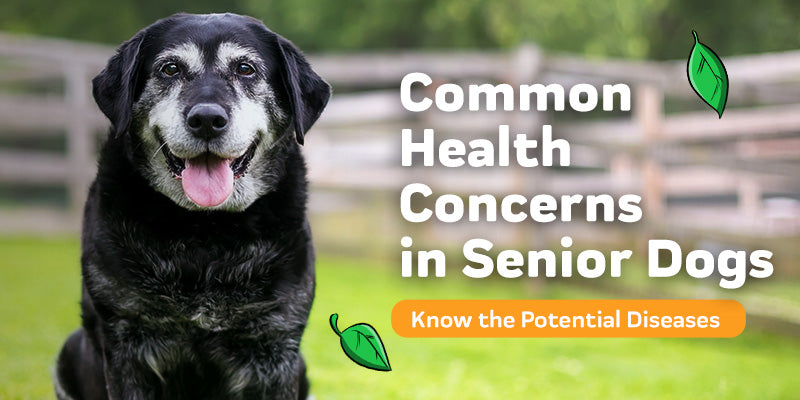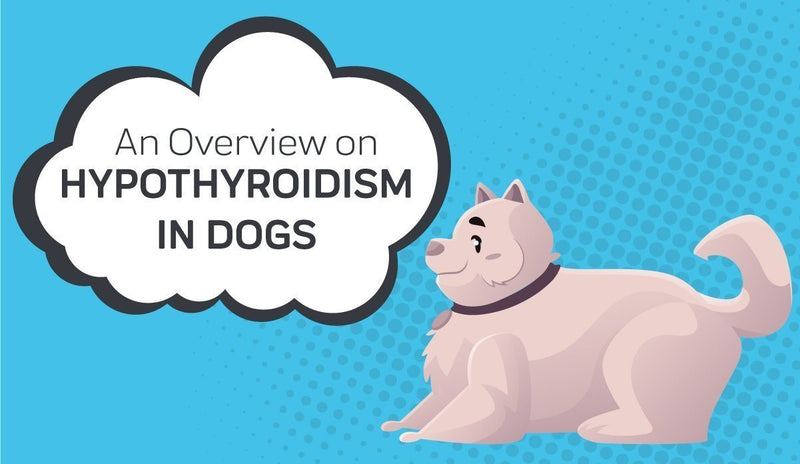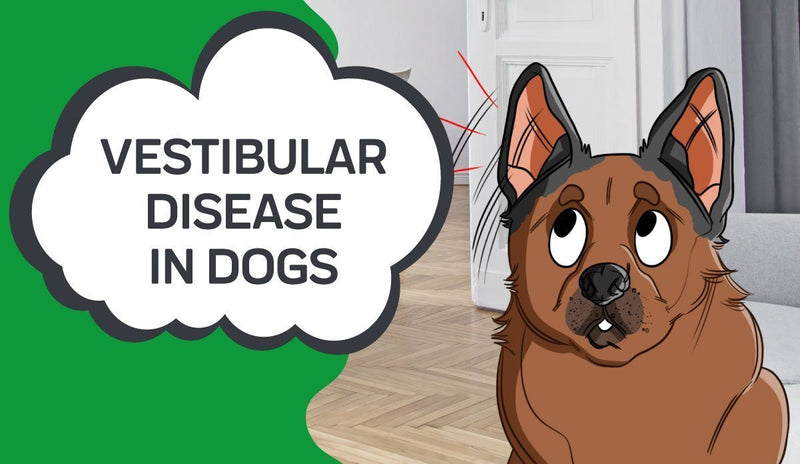
You may have heard the term canine adenovirus thrown around without having much of an understanding of what it is. First, it's one of those medical umbrella terms that really cover a wide variety of diseases. Meaning there are many canine adenoviruses. Read this post to learn what these diseases are, what to do about them, and how CBD oil may help.
What is Canine Adenovirus?
Well, technically, there are several. They are all DNA viruses and they are structurally similar, but they can wreak different kinds of havoc in a dog's body.
Below we'll discuss the two most common types of canine adenovirus, what they are, their symptoms, and what to expect.
Canine Adenovirus Type 1
Canine Adenovirus Type 1, or CAV-1, is the most serious of the two common adenoviruses as it can cause infectious canine hepatitis, otherwise known as ICH, or liver failure.
Thankfully, it is rare in adult dogs that we all keep as pets because they are usually up-to-date on their vaccinations. Young dogs, unvaccinated dogs, and strays are unprotected.
CAV-1 is an infectious disease and the dog is contagious both before and after it displays symptoms. An unprotected dog can contract the disease from the saliva, urine, and feces of an infected dog.
After a few days of infecting the body, the disease travels to the tonsils, then into the bloodstream, and then to the liver.
A dog with a healthy immune system can get rid of the disease, though they will still be contagious for six months afterward.
If they can't rid themselves of the disease, it will turn into infectious canine hepatitis.
Symptoms of Canine Adenovirus Type
CAV1 before it becomes ICH:

- fever
- tonsillitis
- vomiting
- diarrhea
- abdominal pain
- weight loss
- lethargy
- swollen lymph nodes
- enlarged liver
Symptoms of Infections Canine Hepatitis:
- coughing
- runny eyes
- runny nose
- excessive thirst
- increased heart rate
- excessive bleeding
- bleeding under the skin
- swelling, particularly in the head, neck, and body
- abdominal swelling
- jaundice
- seizures
- clouding of the eye with a bluish tint
Canine Adenovirus Type 2
Canine Adenovirus Type 2, or CAV-2, is one of the primary ways dogs can get kennel cough. Thankfully, dogs can be immunized for it, but that means that unvaccinated dogs can still get it, including ones who are just too young to be vaccinated yet.
CAV-2 is infectious, meaning it is contagious and dogs can catch it from an infected dog's spit while coughing, snot, eye discharge, urine, and feces.
The dog's body can usually get rid of the disease themselves, but if it can't, the disease will develop into pneumonia.
Symptoms of Canine Adenovirus Type 2:
- dry coughing
- hacking coughs
- retching
- gagging
- coughing up a white foam-like discharge
- runny nose
- conjunctivitis
- fever
How Dogs Get Adenovirus

Dogs get one of the types of adenovirus from interactions with many of the bodily fluids from infected dogs. Routine vaccinations prevent pets from getting adenovirus, but they must be maintained and dogs who haven't been vaccinated can easily spread it from one to another.
Be aware that an infected dog does not have to be present at the moment of contracting the disease. The uninfected dog just needs to come into contact with infected fluids left for lengths of time after the dog has left.
Now, to discuss where dog's contract adenovirus. There's a reason CAV-2 causes something called kennel cough, and it's because that's a common place to get it. Kennels, shelters, pet stores, dog parks, doggy daycares, groomers, and even open places like beaches and sidewalks can provide opportunities for a dog to catch CAV-1 and CAV-2. The more young or adult unvaccinated dogs pass through an area, the more likely it is for there to be infected fluids in the area.
This can be particularly dangerous for puppies who can't be vaccinated yet. Not only can they get the disease because they are unprotected, but their immune systems are not strong at this age, so they require more drastic medical assistance than an adult dog would with this same disease.
Diagnosing Canine Adenovirus
The diagnosis will begin with the vet observing all visible symptoms and considering all reported ones from you. That last part means you have to tell them everything relevant about the dog's behavior, symptoms, lifestyle, and any recent events that may have exposed the dog to an adenovirus. You may want to make notes ahead of time to be accurate. The next step depends on what the vet concludes from all this information, so it's important that tell all you can.
They may want to rule out distemper and parvovirus because these can be easily confused with adenovirus symptoms. If your vet diagnoses them with either distemper or parvovirus, ask them polite questions or get a second opinion to ensure they've made the right diagnosis.
They may perform blood tests to check their white blood cell count and signs of liver disease, radiographs to look for an enlarged liver, abdominal ultrasonography to get another look at the liver, and urine tests.
Preventing Canine Adenovirus
First, get dogs vaccinated for CAV-2, which protects them against CAV-1 as well. Do this as soon as possible and make sure to keep up with boosters. It is recommended that you get your dog vaccinated every three years.
Before they get the vaccination and while still completing the full set of boosters, you can protect your dog from exposure to an adenovirus by limiting their contact with other young or unvaccinated dogs, limiting visits to kennels and other places that run a lot of dogs through, avoiding places known to have recently had a case of kennel cough, and avoiding known exposure to sick or unvaccinated animals.
Adenovirus Treatment
Treatment for CAV-1 consists of managing symptoms while the dog's body fights the disease. The vet will be concerned with their fluid levels, nutrition, coagulation, kidney health, and getting rest.
In severe cases, the dog's body may be threatened enough that other measures must be taken to address secondary issues, such as antibiotics to treat bacterial infections, intravenous fluids, and blood transfusions.
The good news is that once the dog has recovered from adenovirus, they will be immune for the rest of their life.
The bad news is that the disease may have caused permanent damage to some of their organs. Also, they may have damaged corneas and suffer sensitivity to light, and they experience eye pain.
Treatment for CAV-2 is very similar to treatment for type 1. Because there is no cure and the body can usually clear the disease itself, the dog will simply need assistance managing the symptoms and dealing with any secondary conditions that may arise.
Because CAV-2 causes cough, you should get them a harness to use for their walks because a collar puts pressures on their neck and that can exacerbate the coughs. Not only is it sad to think of them being uncomfortable, but they can hurt themselves coughing and if they are coughing or vomiting blood, you certainly want to limit that.
How CBD Oil Can Help with Adenovirus Recovery
CBD oil may help dogs with canine adenovirus by:
- reducing inflammation
- adding nutrition
- alleviating stress
- decreasing bacterial, viral, and fungal infections
- reducing pain
- easing nausea
- reducing vomiting
- easing diarrhea
- fostering normal appetite
- reducing the frequency and severity of seizures
Science has discovered that dogs and humans have an endocannabinoid system that creates and runs off of its own cannabinoids. This system is crucial to the body's normal functioning. Studies are finding that external cannabinoids, like cannabidiol or CBD oil, help the body regulate the endocannabinoid system more effectively and that they might be powerful solutions to a dizzying array of health issues, including those that come from a canine adenovirus and the side effects of medications used to treat an adenovirus.
Using CBD Oil
CBD oil products come in a wide variety to make delivering cannabidiol possible and even enjoyable for dogs with all kinds of tastes and needs.
CBD oil products for pets include:
- oil tinctures
- extract concentrates
- capsules
- treats

CBD Oil tinctures are one of the most popular options. They are cannabidiol mixed with a carrier oil and often a flavoring. Hemp has a distinctive and rarely unliked taste, so it's common for manufacturers to add a flavor to make the cannabidiol more palatable. If the dog doesn't care or you want to mask the taste with something else, you can go with unflavored and avoid that ingredient. Tinctures come with convenient droppers or sprayers so you can apply the oil directly to the dog's mouth or their food. These are great for achieving specific dosing goals.
Extract concentrates are just cannabidiol in a container. That means they're more cost effective than other options and you don't have to think at all about ingredients, but they also taste exactly like hemp, so you'll have to mask the taste if your dog doesn't like it. They can also be measured exactly, just count the number of bead-like drops that come out.
CBD Capsules skip the whole taste element altogether and are easy to give to dogs who have shown in the past that they don't mind taking pills. The only downside is that your only dosing option is varying how many capsules you give them.
Hemp Dog Treats are the easiest way to get cannabidiol into a dog because they are as tempting as any other treat. They even come in both crunchy and chewy hemp varieties to suit your dog's taste buds. The downside is that they can only be dosed by how many treats you give, like with capsules.
Dosing CBD Oil
It's difficult for anyone to provide specific dosing information because the use of cannabinoids is still so little understood.
You can and should research CBD oil and the symptoms you want to use it for to see what manufacturers, scientists, or vets recommend as well as what pet owners have said works for them.
Packages for treats and capsules will come in small, medium, and large options and tell you a recommended general dose per treat or capsule for that size dog.
It is recommended that you start at the lowest possible dosage for the ailment you are attempting to improve and work up to what provides relief. You can also consult your vet for dosing hemp for dogs.
For one thing, some ailments actually respond better to smaller doses. Also, when you're tweaking the dose, it's more effective to work up than down.
Try to wait a month before changing the dose, but if you can't, wait at least 2 to 4 days. We recommend that you wait the longer period because, while CBD oil can provide some benefits from CBD right away, the full extent of its help may not be seen for a few weeks. You may be changing doses unnecessarily and subjecting you and your dog to unnecessary change.
Doses vary depending on the size, age, weight, and health of the dog. If your dog is unusually young, old, small, or sick, you should give them less CBD oil. Speak to your vet for specific dosing for your dog.
Risks Associated with CBD Oil
CBD oil poses few risks, but it's wise to know about them.
It doesn't appear to be possible for a dog to overdose on CBD oil, but if they are given an unusually large quantity, they may become sedated, lose appetite, or experience diarrhea.
CBD oil can impact how medications are absorbed, to the extent that doses don't work as expected. If your dog is currently on medication or before a vet prescribes any medications or treatments for them, tell the vet you are giving them CBD oil and the amount so they can dose accordingly.
CBD oil has not yet been approved by the FDA because there simply haven't been enough tests and trials yet. This means results cannot be relied on as well as they can with traditional medications. Those medications often pose scary side effects and risks, but their impacts good and bad are well understood by vets.
CBD oil can sometimes provides life-changing benefits for pets with hard-to-treat ailments, but it isn't guaranteed. This makes CBD oil a great, natural alternative for pets who can't take a traditional treatment or who suffer so much from the side effects of a traditional treatment that they may not be able to keep taking it. Your vet should be willing to discuss these possibilities with you. If they are not, you can look for a holistic vet.
Purchasing CBD Oil
Before purchasing a CBD oil product, you should become knowledgeable about the following points to find the safest product for your dog.
Full-spectrum and CBD isolate
These are two important options to be aware of. CBD isolate is just cannabidiol, while full-spectrum cannabidiol retains other cannabinoids, terpenes, and nutrients that come from the hemp plant. Most people lean toward the full-spectrum variety when purchasing a CBD oil product, expecting more benefits, but other people claim CBD isolate actually worked better for them or their dog. The choice is really up to you. Unless research specific to your dog's ailment says otherwise, there is no proof of which one works best except customer review. If your pet is experiencing nausea, vomiting, or loss of appetite that may be limiting their nutrient intake, it may be better for you to start them out with full-spectrum to get the added nutritional benefits. If that doesn't work for you, do try CBD isolate before giving up on CBD oil.
Third-party Testing
Always check the website of a CBD oil product for third-party lab testing results or a Certificate of Analysis. These will tell you everything that's in the CBD oil, what amount is in there, and what isn't in there. Sadly, this is necessary because not all CBD oil manufacturers are reputable and may sell less than the advertised amount of CBD oil or not provide any actual CBD oil at all.
Extraction
Make sure the CBD oil manufacturer specifies that they use the CO2 extraction method. It's the safest and purest method. They should state the extraction method they use on their website.
Origin
The manufacturer needs to tell you where the cannabidiol came from. They may grow the hemp and extract the oil themselves or they may acquire one of those from someone else. Either way, you should be made aware of where it came from so you can ensure it was grown in a country with safe regulations.
Ingredients
Excess ingredients carry risks. They may be unnecessary, unsafe, or something your pet can be allergic too. It's best to pick a CBD oil product with as few ingredients as possible to limit these concerns. Most CBD oil products boast that they are natural because the target market likes natural products, but you can also find organic products.
Innovations from Innovet
Innovet Pet creates CBD oil products to help improve the lives of pets with hard-to-treat ailments. This means we're very aware that some pets have special needs. If your dog with canine adenovirus doesn't respond to traditional treatments or current CBD oil products, let us know so we can try to find a solution for your dog.
Sources:
Canine Adenovirus 1
Overview of Infectious Canine Hepatitis
Infectious Hepatitis (Adenovirus) in Dogs
Adenovirus 1 in Dogs
Canine adenovirus type 2 disease
Approved by:
Dr. Sara Ochoa
Doctor of Veterinary Medicine, St. Georges University

Sara Redding Ochoa, DVM was raised in north Louisiana. She graduated from LA Tech in 2011 with a degree in animal science. She then moved to Grenada West Indies for veterinary school. She completed her clinical year at Louisiana State University and graduated in 2015 from St. George’s University. Since veterinary school she has been working at a small animal and exotic veterinary clinic in east Texas, where she has experience treating all species that walk in the hospital. In her free time, she likes to travel with her husband Greg, bake yummy desserts and spend time with her 4-legged fur kids, a dog Ruby, a cat Oliver James “OJ”, a rabbit BamBam and a tortoise MonkeyMan.
Thanks for stopping by!
P.S. We Love You!
Sincerely,
The Innovet Team
Please do not ask for emergency or specific medical questions about your pets in the comments. Innovet Pet Products is unable to provide you with specific medical advice or counseling. A detailed physical exam, patient history, and an established veterinarian are required to provide specific medical advice. If you are worried that your pet requires emergency attention or if you have specific medical questions related to your pet’s current or chronic health conditions, please contact or visit your local/preferred veterinarian, an animal-specific poison control hotline, or your local emergency veterinary care center.
Please share your experiences and stories, your opinions and feedback about this blog, or what you've learned that you'd like to share with others.
















